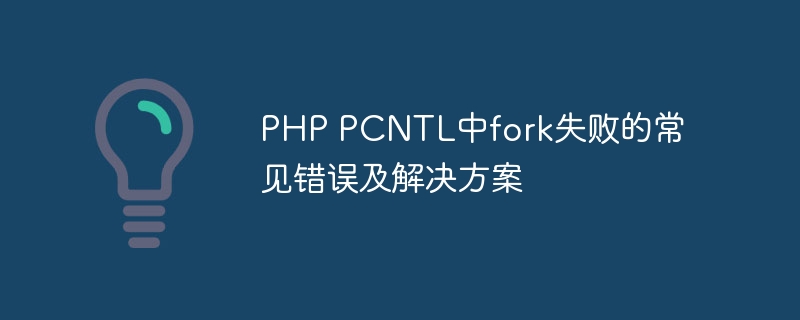Common errors and solutions for fork failure in PHP PCNTL

Common errors and solutions for fork failure in PHP PCNTL
When using the PHP PCNTL extension for process management, you often encounter the problem of fork failure. Fork is a method of creating a child process. In some cases, the fork operation may fail due to some errors. This article will introduce some common fork failure errors and corresponding solutions, and provide specific code examples to help readers better understand and deal with these problems.
1. Insufficient memory
Possible error message: Cannot allocate memory
When the system memory is insufficient, the fork operation will fail and return the above error message. In this case, we can solve the problem by freeing some memory or adjusting the system's memory allocation strategy.
// 释放一些内存 unset($largeArray);
2. Exceeding the limit on the number of processes
Possible error message: Resource temporarily unavailable
In some systems, there is a limit to the maximum number of processes in the system. When the process When the number reaches the upper limit, no new processes can be created, causing the fork to fail. This problem can be solved by adjusting the system ulimit value.
// 查看当前ulimit值 $ulimit = `ulimit -u`; echo $ulimit; // 修改ulimit值 `ulimit -u 1024`;
3. Insufficient file descriptors
Possible error message: Too many open files
Each process will occupy file descriptors when operating files. If the system If the number of file descriptors reaches the upper limit, the fork operation will also fail. This problem can be solved by increasing the system's file descriptor limit.
// 查看当前文件描述符数 $openFiles = `ulimit -n`; echo $openFiles; // 修改文件描述符数 `ulimit -n 1024`;
4. The PCNTL extension is not installed or enabled
If the PCNTL extension is not installed in the system or the PCNTL extension is not enabled in the php.ini file, the fork operation will naturally fail. This problem can be solved by installing the PCNTL extension and enabling it in php.ini.
// 检查PCNTL扩展是否已安装
if (!extension_loaded('pcntl')) {
die('PCNTL extension is not installed.');
}5. pcntl_fork function call fails
Sometimes even if the above problems are solved, the fork operation may still fail. In this case, you can use the return value of the pcntl_fork function to determine whether the fork operation is successful. If the return value is less than 0, the fork failed.
$pid = pcntl_fork();
if ($pid == -1) {
die('Fork failed.');
} elseif ($pid) {
// Parent process
} else {
// Child process
}In general, through the above solutions, we can effectively avoid the problem of fork operation failure in PHP PCNTL, and better understand how to handle these errors through code examples. I hope this article will be helpful to readers when using PCNTL extensions for process management.
The above is the detailed content of Common errors and solutions for fork failure in PHP PCNTL. For more information, please follow other related articles on the PHP Chinese website!

Hot AI Tools

Undresser.AI Undress
AI-powered app for creating realistic nude photos

AI Clothes Remover
Online AI tool for removing clothes from photos.

Undress AI Tool
Undress images for free

Clothoff.io
AI clothes remover

AI Hentai Generator
Generate AI Hentai for free.

Hot Article

Hot Tools

Notepad++7.3.1
Easy-to-use and free code editor

SublimeText3 Chinese version
Chinese version, very easy to use

Zend Studio 13.0.1
Powerful PHP integrated development environment

Dreamweaver CS6
Visual web development tools

SublimeText3 Mac version
God-level code editing software (SublimeText3)

Hot Topics
 CakePHP Project Configuration
Sep 10, 2024 pm 05:25 PM
CakePHP Project Configuration
Sep 10, 2024 pm 05:25 PM
In this chapter, we will understand the Environment Variables, General Configuration, Database Configuration and Email Configuration in CakePHP.
 PHP 8.4 Installation and Upgrade guide for Ubuntu and Debian
Dec 24, 2024 pm 04:42 PM
PHP 8.4 Installation and Upgrade guide for Ubuntu and Debian
Dec 24, 2024 pm 04:42 PM
PHP 8.4 brings several new features, security improvements, and performance improvements with healthy amounts of feature deprecations and removals. This guide explains how to install PHP 8.4 or upgrade to PHP 8.4 on Ubuntu, Debian, or their derivati
 CakePHP Date and Time
Sep 10, 2024 pm 05:27 PM
CakePHP Date and Time
Sep 10, 2024 pm 05:27 PM
To work with date and time in cakephp4, we are going to make use of the available FrozenTime class.
 CakePHP File upload
Sep 10, 2024 pm 05:27 PM
CakePHP File upload
Sep 10, 2024 pm 05:27 PM
To work on file upload we are going to use the form helper. Here, is an example for file upload.
 CakePHP Routing
Sep 10, 2024 pm 05:25 PM
CakePHP Routing
Sep 10, 2024 pm 05:25 PM
In this chapter, we are going to learn the following topics related to routing ?
 Discuss CakePHP
Sep 10, 2024 pm 05:28 PM
Discuss CakePHP
Sep 10, 2024 pm 05:28 PM
CakePHP is an open-source framework for PHP. It is intended to make developing, deploying and maintaining applications much easier. CakePHP is based on a MVC-like architecture that is both powerful and easy to grasp. Models, Views, and Controllers gu
 CakePHP Creating Validators
Sep 10, 2024 pm 05:26 PM
CakePHP Creating Validators
Sep 10, 2024 pm 05:26 PM
Validator can be created by adding the following two lines in the controller.
 CakePHP Working with Database
Sep 10, 2024 pm 05:25 PM
CakePHP Working with Database
Sep 10, 2024 pm 05:25 PM
Working with database in CakePHP is very easy. We will understand the CRUD (Create, Read, Update, Delete) operations in this chapter.






